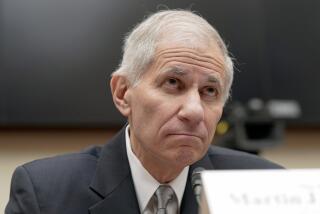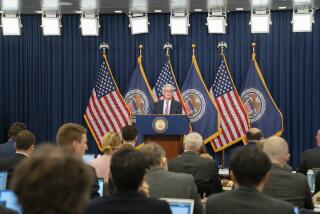FDIC Chairman Seidman Will Resign : Despite Rifts Over Policy, Treasury Secretary Lauds Man Who Led S&L; Cleanup
WASHINGTON — L. William Seidman, the outspoken federal regulator who has been overseeing the massive savings and loan cleanup while trying to avert a similar taxpayer bailout of banks, said Tuesday that he will resign Oct. 16 as chairman of the Federal Deposit Insurance Corp.
In a letter to President Bush, Seidman, 70, said he would step down when his term expires in 10 weeks.
Although Seidman has long proclaimed his intention to leave this fall, he said recently that he was “discussing” his future with the Bush Administration, a hint that he might consider staying on.
Seidman’s departure comes during a crucial period for the nation’s troubled financial institutions. Congress next month is to begin debating whether to allocate a further $80 billion to the S&L; bailout. At the same time, the lawmakers will wrangle over a massive overhauling of the Depression-era banking laws and decide how best to rescue the dwindling bank deposit insurance fund.
Treasury Secretary Nicholas F. Brady, whose department often sparred with Seidman over regulatory and legislative issues, praised the departing regulator. “He has had a distinguished career,” Brady said. “His seasoned background and expertise of the banking industry have proved invaluable and will be sorely missed.”
Brady’s complimentary farewell message made no reference to Seidman’s frequent clashes with the Administration over the independence of the FDIC. The White House sought last year to persuade him to resign, but he refused and insisted that he would serve out his term.
Seidman often prevailed against the Treasury in political disputes because he enjoyed respect in Congress, where he frequently deflected criticism and skepticism about banking policies with well-chosen quips. His successor probably will be viewed with less patience and could be caught in the cross-fire of intensified partisan sniping between the Democratic-controlled Congress and the Bush Administration over how to correct weaknesses in the savings and banking industries.
The power Seidman wielded may also be dissipated. He was both head of the bank insurance fund and overseer of the Resolution Trust Corp., the agency Congress set up to handle the disposal of hundreds of defunct S&Ls.; But Congress, impatient with the performance of the RTC, may change the law to give the organization its own independent chief.
When the White House thought last May that Seidman would leave soon, Bush named the Federal Reserve Board’s top banking regulator, William Taylor, to replace Seidman. But Bush said Tuesday “we’ll start over and take a hard look. There’ll be some names coming my way.”
“I don’t want to get ahead of where we are. . . . There’s no firm decision,” Bush told reporters aboard Air Force One while en route to Kennebunkport, Me., to begin a four-week vacation.
Sen. Christopher J. Dodd (D-Conn.), an influential member of the Banking Committee, predicted that the Administration ultimately will choose Taylor to succeed Seidman. Dodd said that would signal that “the Administration is opting to put expertise and experience above divisiveness and partisanship.”
Taylor is “more an inside man and a team player,” and less likely to disagree with the Administration on the cost and duration of the S&L; bailout, as Seidman sometimes did, a financial industry lobbyist said Tuesday.
Seidman, in his resignation letter to Bush, said: “It has been a privilege to serve during your Administration and particularly under your great leadership. Please do not hesitate to call on me if I can be of service to you in the future.”
In response to the resignation, the President said only: “I don’t think it’s unexpected. . . . He’s indicated some time ago that he was willing to stay until around this period of time.”
But tributes from Congress began immediately, with lawmakers aware that Seidman will remain a major player in the debate over financial legislation, even in his final weeks in office.
“The departure of Bill Seidman will leave a big void in the nation’s regulatory structure,” House Banking Committee Chairman Henry B. Gonzalez (D-Tex.) said. “He has been a strong voice willing to lay out the hard facts about the industry’s problems. He maintained great credibility on Capitol Hill during the most difficult period in the history of the Federal Deposit Insurance Corp.”
Senate Banking Committee Chairman Donald Riegle (D-Mich.) called Seidman’s departure “a great loss to the government,” and added: “I have the highest regard for him and he will be very difficult to replace.”
Seidman said in an interview Tuesday that he offered his formal resignation now “because I wanted to give them a chance to get their new man in there. I came to the job expecting to stay two years, and I stayed for six.”
His decision to serve his full term in the face of White House displeasure was typical of his determination. He was thrown from a horse last year, suffered a broken pelvis and nearly died after losing 40% of his blood. Three weeks later, he was back at work.
Seidman has been serving since 1985 as chairman of the FDIC, which insures bank deposits up to $100,000, and has been coping with the biggest wave of bank failures since the Great Depression. The insurance fund will become insolvent by year’s end, Seidman has warned Congress. He has urged quick passage of legislation to replenish the fund.
He donned his other hat in early 1989, when the Administration gave him emergency orders to seize more than 200 ailing thrifts and run them with FDIC personnel. Congress created the RTC later that year, establishing a structure that left Seidman in charge of the thrift cleanup.
The RTC was opened for business with personnel borrowed from the FDIC, and has expanded dramatically--it has $163 billion in assets from failed institutions, including securities, mortgages, delinquent loans and thousands of pieces of real estate, from luxury hotels to raw land.
Although Seidman moved quickly as an administrator, his candor irritated people in the Administration. Early in 1989, he had brushed aside Brady’s suggestion that depositors pay a tax on their savings to help the beleaguered S&Ls.; Seidman called the proposal “the reverse-toaster theory . . . instead of the bank giving you a toaster for making a deposit, you give them one.”
Seidman said he will not retire to his New Mexico ranch when he leaves his job in October. “People on Wall Street want to talk to me, and also various law firms and businesses. I’ll be more than happy to talk to them,” he said.
He was cautiously optimistic about the future for banks and S&Ls;, but was careful to avoid making a prediction that might come back to haunt him. “I think things have perhaps reached bottom,” he said. “It will still take a while to straighten things out. The recovery is not clear enough to make predicting very easy.”
Seidman has enjoyed a varied business and political career. He built the family accounting firm, Seidman & Seidman, into a major national one and was a special White House assistant in the Gerald R. Ford Administration.
Bio: L. (Lewis) William Seidman The chairman of the Federal Deposit Insurance Corp. and the Resolution Trust Corp. announced his resignation effective Oct. 16.
Age: 70
Born: Grand Rapids, Mich.
Education: Graduated Phi Beta Kappa from Dartmouth College, received a law degree with honors from Harvard and an MBA from the University of Michigan.
Family: Seidman and his wife, Sally, have been married 47 years; they have six grown children. The family shares artistic interests: Seidman’s mother was a sculptor, Sally paints and daughter Tracy is an artist who also manages the family’s working cattle ranch in Wagon Mound, N.M.
Resume: Seidman ran for Michigan state controller in the early 1960s and lost, then worked as a financial affairs assistant to George Romney and was chief fund-raiser for Romney’s short-lived presidential campaign. He next went into the family’s accounting business and built it into a national concern before returning to the public sector as assistant for economic affairs to President Ford from 1974 to 1977. Seidman became chief financial officer of Phelps Dodge, a Phoenix-based copper producer, then dean of Arizona State University’s business school from 1982 to 1985, when he was appointed chairman of the FDIC.
Business philosophy: “We’ll be a lucky nation if we can dispose of the backlog of insolvent S&Ls; in 10 years.”
Quote: In 1989, Seidman characterized an Administration proposal to tax deposits to raise money for the S&L; cleanup as “the reverse toaster theory.” Instead of the bank giving you a toaster, when you make a deposit, you give them one.
More to Read
Get the L.A. Times Politics newsletter
Deeply reported insights into legislation, politics and policy from Sacramento, Washington and beyond. In your inbox three times per week.
You may occasionally receive promotional content from the Los Angeles Times.










